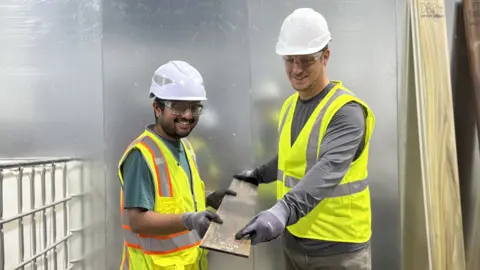**Do You Feel Lucky, Plank? Meet the New ‘Bulletproof’ Wood**
The world of construction is evolving rapidly, and innovations are increasingly turning toward sustainable materials. One such groundbreaking development is a revolutionary type of modified wood called Superwood, created by the US-based company InventWood. This new material challenges conventional perceptions of wood and timber, claiming to be stronger than steel and even capable of withstanding high-velocity projectiles.
**The Innovative Power of Superwood**
InventWood’s co-founder and executive chairman, Alex Lau, advocates for the use of Superwood in building applications, suggesting it can provide enhanced safety for structures, potentially serving in military capacities. During laboratory tests, standard wooden panels were easily penetrated by projectile-like objects, whereas Superwood held its ground, demonstrating remarkable resilience. Lau humorously notes that while they haven’t yet “tried dropping bombs on it”, the testing results are significant enough to warrant serious consideration for military and architectural applications.
The construction industry faces a mounting challenge in finding sustainable materials to replace concrete, notorious for its high greenhouse gas emissions. Traditional timber may offer aesthetic and environmental benefits, but it lacks the durability needed in various applications, often deteriorating when exposed to moisture and insects. This is where engineered wood, like Superwood, comes into play, promising strength and longevity much beyond what natural wood can offer.
**How Superwood is Made**
Mr. Lau refers to a sophisticated treatment process that involves extracting lignin—a natural polymer present in wood—then compressing the timber to remove air and imperfections, thereby reducing its volume considerably. This transformation results in a material that is approximately 80% denser and incorporates numerous additional hydrogen bonds, contributing to its enhanced strength. Besides structural integrity, this process allows Superwood to retain a pleasing grain, providing the aesthetic qualities that traditional wood offers.
**Retaining a Place in Construction**
The journey to creating Superwood has not been easy; the process, which previously took over a week, has now been refined to a matter of hours, significantly enhancing production efficiency. Currently, the company’s primary source of raw material will be poplar trees, but Lau has also stated interest in employing bamboo, which has a rapid growth cycle, thereby offering an efficient means to sequester carbon from the atmosphere.
While there are already numerous engineered wood products on the market—such as glulam (glue-laminated timber) or cross-laminated timber (CLT)—Superwood aims for a different position within the industry. CLT has proven effective in reducing carbon emissions when used instead of concrete; however, Superwood could serve as a visually appealing and structurally robust finishing layer or durable cladding material.
**Concerns and Future Perspectives**
Despite the promise shown by Superwood, there are still critical challenges that require attention. Experts like Morwenna Spear from Bangor University emphasize the need for substantial testing data, especially regarding the wood’s performance in adverse weather conditions typical of regions like the UK. The concerns surrounding the durability of wood against climatic fluctuations cannot be overlooked as it becomes a common choice for external structures.
Moreover, Professor Michael Ramage has expressed skepticism about the mortgage and insurance rates for wooden structures compared to traditional concrete buildings, pointing out the logistical barriers still facing the broader implementation of engineered wood in construction.
Addressing safety and regulatory concerns is paramount, especially in light of destructive wildfires or significant insect infestations. Lau remains optimistic, asserting that Superwood has passed tests on fire resistance and insect durability, although he acknowledges the complexity involved in working with engineered wood compared to regular timber.
**The Bigger Picture in Construction Innovation**
As the trend shifts towards utilizing engineered wood products, it is essential not to overlook the potential for recycling existing timber. Incorporating reclaimed wood in new applications helps reduce waste while conserving existing natural resources. The increasing variety of wood products available means that designers and architects today enjoy a richer palette of materials to choose from, pushing the boundaries of how—and what—can be built while emphasizing sustainability and environmental consciousness.
Overall, while Superwood may not yet be a household name, its potential could revolutionize how we think about building materials, challenges equivalent to those posed by concrete, and the future of sustainable construction strategies. The journey for this modified wood is just beginning, but with its remarkable properties and ongoing innovations, Superwood holds the promise of a “bulletproof” solution for the construction industry.












